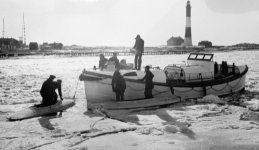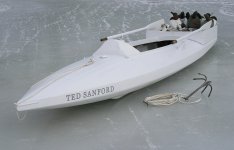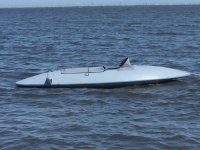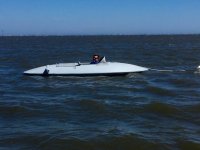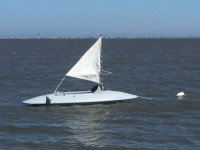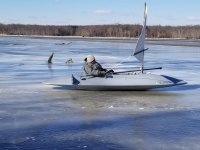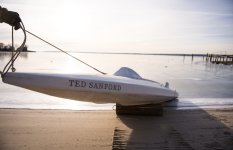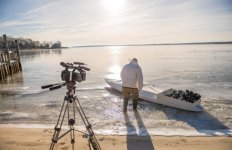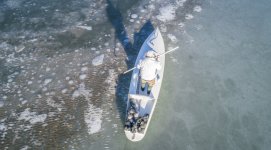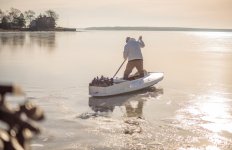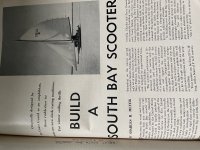Good morning, Eric~
As I understand it, the Scooter was first developed for baymen to negotiate the patchwork of hard ice, soft ice and open water that is so common on Great South Bay winters. The baymen were primarily in pursuit of clams and eels - and also ducks, geese and Brant - for the market and used a variety of flat-bottomed skiffs, often with a pair of iron runners, to be dragged or piked over the ice. The originator (see more below) was Capt. Wilbur R. Corwin. I know he was a duck guide. What made the Scooter different from simpler vessels was shape of the bottom shape and the runners that enabled it to sail over the ice, "safely" enter air holes (patches of open water, and then "scoot" right back up onto the ice whilst under sail. The baymen's rigs were relatively small and could be struck and laid on the deck when the baymen got to work - clamming, eeling or gunning.
I am not sure if Wilbur R. (as distinct from his son Wilbur A.) was in the Coast Guard - or, more correctly, the Life Saving Service back in his day. There was a "life-saving station" right near his "duck lodge". I imagine there was informal use of Scooters by the LIS/USCG. My Holy Grail would be to find the documentation of the Coast Guard ordering a batch of Scooters from Benjamin Hallock or other known builders. In any even, they were developed for baymen and later adopted by the Coast Guard.
Here is an excerpt from a narrative I wrote for the Pattersquash Centennial last March at our LI Decoy Collectors Show:
Many Scooters were fitted with a small sailing rig to sail across the ice – then through the water – then back up onto the ice. It is this unique capability that gave the Scooter its name. The first was built by Capt. Wilbur R. Corwin in Bellport – with help from Richard B. Hamel - in 1874 or so. The local blacksmith, Joseph Shaw, made the metal runners – but Wilbur R. developed the bevel and rocker in the wooden portion of the ice runners that gave it the ability to sail well – steered with the jib in the later racing Scooters.
The fantail served a couple of important purposes. Although it undoubtedly hides better than a traditional plumb transom – especially from oncoming Broadbill and Redheads when hunting the bay, anchored bow and stern in open water – its more important function was in the ice. When hunting in the ice, the gunner typically wanted to get to some open water – known as an “air hole” – where ducks and geese could find food. To get there, the gunner could drag or sail or “pike” with a special pole. Ice on tidal waters varies markedly in thickness and strength. Sometimes a Scooter would drop down through softer ice - and sometimes it was easier to back out than it was to continue on forward. In such instances, the fantail – rounded and above the waterline – would enable the gunner to get back up on the ice by going in “reverse”. (He would propel the vessel in the chosen direction with either a pike pole or a small grapnel anchor on 40-or-so feet of line – to “kedge” back onto the ice.
I restored the TED SANFORD about 10 years ago.
View attachment 58222
I have yet to hunt it in its refreshed condition. With our warmer winters, Great South Bay seldom has the ice cover that spurred the development of the Scooter. I keep hoping that a January will provide what I need to once again get on the ice and drag and pike my way out to an air hole - whilst this old body can still do the work. Once that is accomplished, my next task will be to find a permanent home for this bit of history.
All the best,
SJS


